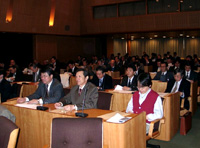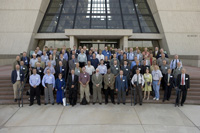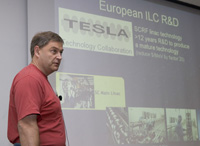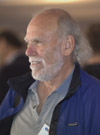 |
|
|
 |
Industry Corner: Linear Collider Forum of Japan

A meeting of the Linear Collider Forum of Japan. |
For many decades, Japanese industrial companies have been interested
in accelerator technology development in collaboration with the physics community.
Accelerator technology is the mother of high technology, which is applicable to
industrial products. Superconducting technology, for example, has been transferred
to electric power business, high field magnet technology, scientific apparatus,
ultra high vacuum technology, and semiconductor business to name a few. As a result
of this collaboration, the industries played a very important role in accelerator
system construction in Japan, mainly from component fabrication and
system integration.
TRISTAN and KEKB are good examples of accelerator systems constructed in Japan.
Other examples are SPring-8 in the synchrotron radiation research and HIMAC
in medical applications. High-tech components made in Japan such as
superconducting magnets and their iron core materials have been installed in U.S.
and European accelerator systems. One Japanese company also recently started constructing
a medical proton synchrotron accelerator for cancer therapy in the U.S.
The Linear Collider Forum of Japan was officially founded on 1 October
2002. More than 100 people from 43 leading industrial companies, including electric
machinery, heavy industry, iron and steel, utilities, electronics and computer,
architect engineering, and general construction participated in the meeting. The
number of member companies has gradually increased since the first meeting to
62 industries at present.
Major activities of the Forum are to provide the opportunity for information
exchange between the physics community, industries and the member companies.
The Forum looks forward to working together with the Linear Collider Forums
of other regions in the future.
--Norihiko Ozaki, Secretary-General of Linear Collider Forum of Japan
|
 |
|
|
 |
Upcoming meetings, conferences, workshops
ILC Industrial Meeting
Fermilab, USA, 21-22 September, 2005
SMTF Collaboration Meeting
Fermilab, USA, 5-7 October 2005
Nanobeams 2005
Kyoto, Japan, 17-21 October 2005
European GDE Meeting
Oxford, England, 24-25 October 2005
ECFA ILC Workshop
Vienna, Austria, 14-17 November 2005
TESLA Technology Collaboration Meeting
Frascati, Italy, 5-6 December 2005
GDE Meeting
Frascati, Italy, 7-10 December 2005
2006 LCWS 2006
Bangalore, India, 9-15 March 2006
|
ILC Industrial Forum at Fermilab

Representatives from more than fifty industries in the U.S. and Canada are attending
the ILC Industrial Forum, hosted by the Linear Collider Forum of America.
|
|
 |
 |
|
|
 |
First Day of ILC Industrial Forum Educational; Working Group Discussions to Follow Today

DESY's Nick Walker reported on European ILC Industrialization at yesterday's meeting. |
After the first day of the International Linear Collider Industrial Forum, more than fifty industries from across the United States and Canada have a clearer picture of the physics behind the ILC and the road ahead for making the proposed project a reality. Hosted by the Linear Collider Forum of America, this first industrial meeting in the United States aims to educate interested industry members and begin to establish an industrialization process for all three regions involved in the ILC.
"The ILC is a major international project, and the industrial issues must be integrated throughout all phases of the project", said Ken Olsen, President of the LCFOA. "We are really just getting started. If we can get a real communication started now between scientists and industry, we can avoid many future pitfalls."
One of the questions on everyone's mind was siting. "The ILC will be built as an international project, and at some point, there will be a site selection," said Fermilab Director Pier Oddone. "It could happen that the ILC is not built here in the U.S. In that case, the ILC would still be Fermilab's highest priority, and the lab would play a large role in the technical components and coordinate the U.S. contributions. From the industrial perspective, if the ILC gets built anywhere, there will be heavy involvement of industries everywhere."
DESY's Nick Walker and Dieter Proch, who joined the meeting via teleconference, reported on ILC industry activities in Europe. Norihiko Ozaki , Secretary-General of the Linear Collider Forum of Japan, reiterated the importance of scientists working closely together with industries in this early stage of the project. "Don't climb Mt. Everest without setting a base camp first," Ozaki said. "Industry will provide you with the harness that you will need for climbing."
The second day of the forum will include talks on the European Linear Collider
Forum and ILC Communications. Working groups on technical subsystems will spend
the afternoon having smaller meetings. A complete agenda and talks are
available online.
--Elizabeth Clements
|
 |
|
|
 |
From FYI: AIP Bulletin of Science Policy News,
19 September 2005
Recent Data on U.S. and Foreign Graduate Students
Graduate physics departments across the country report that foreign students are facing fewer problems due to visa restrictions than two years ago. The departments also report experiencing recent increases in the number of highly-qualified applicants who are US citizens, according to a report from the American Institute of Physics (AIP). Another report, from the National Science Foundation (NSF), found that enrollment by US students in science and engineering graduate programs across the country has turned upward in the last few years, after declining through the 1990s.
AIP Report: "Physics Students from Abroad: Monitoring the Continuing Impact of Visa Problems":
A September 2005 report from AIP's Statistical Research Center indicates that the impact of post-9/11 visa restrictions on physics graduate departments has lessened between the Fall of 2002 and the Fall of 2004. The report suggests that recent declines in the percentage of incoming physics graduate students who are foreign may be largely due to other factors, including an "increase in the number of well-qualified US-citizen candidates."
Read more
|
|
 |
 |
|
|
 |
External Entities
My job as GDE Director has been defined by the International Linear Collider
Steering Committee (ILCSC) in the Annex of the MOU between collaborating
institutions. This document, which is still being finalized, lists as one

Barry Barish
|
of my responsibilities in Section 5.3 of the Annex "he/she will be the primary
representative for the project in interactions with external entities ..."
This turns out to be a rather consuming but not uninteresting part of my job, as these "entities" turn out to vary from various scientific or technical groups to press, school kids and the public.
In the past couple of weeks, I have given presentations to two of these "external entities" that I thought were worth sharing with the ILC community today. In both cases the interest relates to how the growing ILC design effort will fit into the broader context of the worldwide high energy physics program. To achieve our goals for the GDE, we will require increased resources over the coming few years, if we are to accomplish a design and costing effort, initialize partnerships with industry and continue our R&D program to support the baseline and alternatives for the machine. How do our ILC/GDE ambitions fit into the other ambitions for particle physics projects in the coming years?
In 2001, a HEPAP subpanel that I co-chaired with Jon Bagger of Johns Hopkins was charged with the job of creating a long range plan for particle physics for the U.S. One outcome of that study was the realization that there was no mechanism in place that involved the scientific community in determining priorities nationally between projects that cost approximately $100-500M. Projects could be approved by one laboratory, and then end up competing for funding with other such initiatives from another laboratory. In order to insure sufficient community input into the resulting difficult and important priority decisions, the HEPAP long range subpanel recommended the creation of the "Particle Physics Project Prioritization Panel (P5)."
Read more
--Barry Barish
Director's Corner Archive
|
 |
|
|
 |
European GDE Meeting
The European GDE members will meet at Oxford University, England
24-25 October 2005 to discuss matters of a specifically European
interest, in particular optimisation of R&D and preparation for
further bids to the EU and elsewhere, and outreach. There will
be a dinner on the night of 24 October. Accommodations can
be arranged in Oxford, either in a hotel or a guest room in a college.
The meeting is intended for European GDE members, but all GDE members
are invited to attend. If you would like to attend, respond to
Brian Foster
and Sue Geddes by October 10.
SMTF Collaboration Meeting, 5-7 October 2005
There will be an SMTF Collaboration Meeting at Fermilab on 5-7 October
2005. Barry Barish and Gerry Dugan will attend the first day of the meeting
and participate in some of the working group discussions. A proposed
agenda is still being written and will be available on the ILC
Web site soon. Stay tuned to ILC NewsLine for more information
about this meeting.
ILC Jobs
Several ILC job openings are now posted on the ILC Web site.
If you have a job opening that you would like posted, send it to webmaster@ilcgde.org.
Recent ILC Related Preprints
hep-ph/0509159 - Physics at Future Linear Colliders, 15 Sept. 2005
hep-ph/0509160 - Probing the Universal Randall-Sundrum Model at the ILC, 15 Sept. 2005
hep-ph/0509161 - Event shape discrimination of supersymmetry from large extra dimensions at
a linear collider, 15 Sept. 2005
physics/0509051 - TPC Performance in Magnetic Fields with GEM and Pad Readout, 7 Sept. 2005
If you recently released a preprint related to the ILC,
let us know!
|
|

